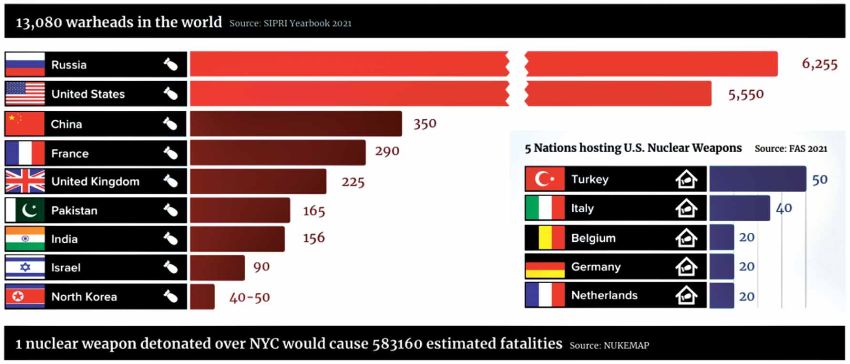
The escalating crisis in Ukraine is all the more terrifying due to the vast arsenal of nuclear weapons held by both Russia and members of NATO, particularly the United States. It also shows that the stockpiling of nuclear weapons is not a deterrent to war, but actually exacerbates tensions and causes wars.
Nuclear deterrence involves countries developing and holding superior nuclear weapons supposedly as a strategy to deter an enemy from attacking. It was developed in the US in the 1950s by conservative policy makers, intellectuals and military leaders. Contemporary advocates of nuclear missiles, such as NATO, view nuclear deterrence as fundamental to security.
However, stockpiling and developing new, more powerful nuclear weapons fuels political and psychological warfare, as does NATO’s practice of sharing weapons and technology between the NATO allies for so-called “security guarantees”. Although NATO claims it is not sharing nuclear weapons, this is exactly what it does in Europe.
Nine countries — Russia, the United States, the United Kingdom, France, China, India, Pakistan, Israel and North Korea — collectively hold an estimated total of 13,080 nuclear warheads, according to the International Campaign to Abolish Nuclear Weapons (ICAN). While this is fewer than the 60,000 held during the height of the Cold War, it is still a huge number.
Even after the Cold War ended, the stockpiling of nuclear weapons for political leverage and intimidation has continued, despite ongoing opposition from anti-nuclear activists and NGOs, and despite treaties such as the Treaty on the Non-Proliferation of Nuclear Weapons, the 1991 and 1993 Strategic Arms Reduction Treaties (START) and the 2021 New START which aim to reduce the number of nuclear warheads in existence.
Huge profits continue to be made by manufacturers of nuclear weapons and nuclear delivery systems, like Boeing and Lockheed Martin.
Russia possesses the largest stockpile of 6255 nuclear weapons, 1458 of which are deployed. The US holds 5500 weapons, 1389 of which are deployed. Of significance to the current situation, 150 of these US nuclear warheads are stationed in Europe in NATO countries as part of NATO’s policy of nuclear deterrence against Russia: Turkey holds 50 US weapons; Italy 40; Belgium 20; Germany 20; and The Netherlands 20.
On top of this, NATO member France holds 290 nuclear weapons and Britain, also a NATO member, has 225 weapons. As if this wasn’t enough, ICAN says that 26 countries, including Australia, endorse nuclear weapons by enabling and allowing alliances like NATO and the Collective Security Treaty Organisation to use nuclear weapons on their behalf.
None of the 30 members of NATO have signed the UN Treaty on the Prohibition of Nuclear Weapons.
Since 2014, Russia-NATO tensions have intensified. Ukrainian President Volodymyr Zelensky approved Ukraine’s new National Security Strategy in September 2020, with the aim of joining NATO. The prospect of Ukraine joining NATO and potentially hosting NATO/US nuclear weapons is seen by Russia’s leaders as a direct threat.
The erosion of non-nuclear proliferation agreements is another factor underlying the current crisis. The dissolution of the 1987 Intermediate-Range Nuclear Forces (INF) Treaty in 2019 is one of these factors.
The INF treaty required the US and the former Soviet Union to eradicate all of their nuclear and conventional ground-launched ballistic and cruise missiles with ranges of 500 to 5,500 kilometres. But, since 2015, accusations of non-compliance from each side have led to the breakdown of the treaty. In February 2019 the US Donald Trump administration announced its intention to withdraw from the treaty. Russia followed suit.
This has allowed both countries to increase their nuclear capabilities.
Hans M Kristensen and Matt Korda of the Federation of American Scientists say that “Russia is in the middle of a decades-long modernization of its strategic and nonstrategic nuclear forces to replace Soviet-era weapons with newer systems”.
Meanwhile, the US is also steadily modernising and expanding the capabilities of its nuclear arsenal, spending $37.4 billion on nuclear weapons in 2020 alone.
Within this context, Putin’s February 27 decision to put Russia’s nuclear defence on stand-by after invading Ukraine is very disturbing. Russia always has about 900 nuclear weapons on trigger alert and the US also keeps about 800 nuclear weapons on hair-trigger.
Adding to the growing threat of a nuclear catastrophe is the recent referendum on nuclear weapons in Belarus, which approved changes to the Belarusian Constitution to end its status as a nuclear weapons-free country, allowing it to host nuclear weapons.
Russia must pull out of Ukraine and NATO must stop its expansion. In addition, all parties need to stop the nuclear arms race and sign on to the UN Treaty on the Prohibition of Nuclear Weapons because, as its preamble states, nuclear weapons pose an existential threat to humanity.
You can help Green Left campaign for a peaceful and non-nuclear future by becoming a supporter or making a donation to our Fighting Fund.